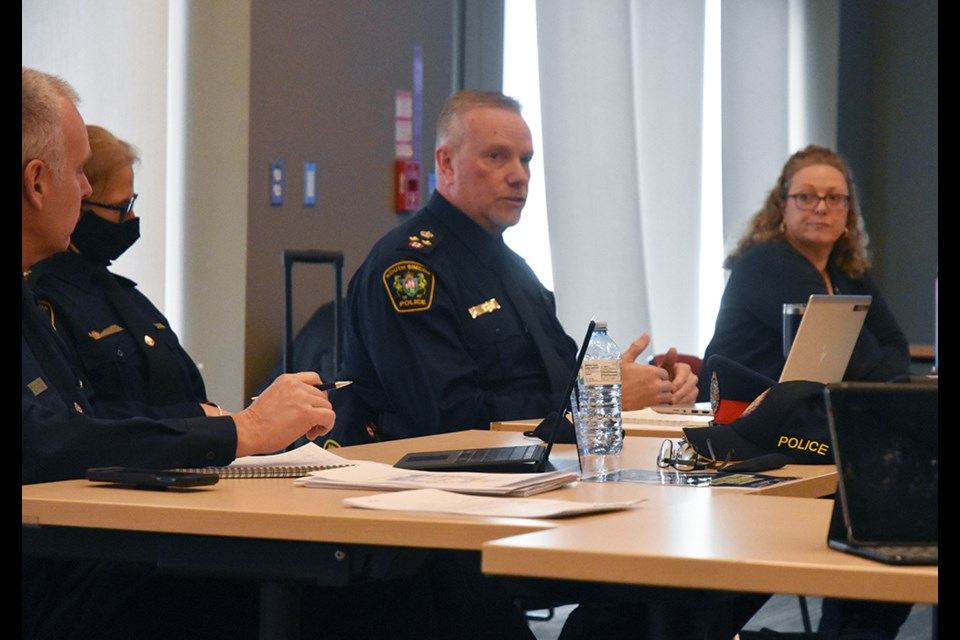South Simcoe police hasn’t yet brought forward a request for body-worn cameras for its officers, but at this week's Bradford West Gwillimbury-Innisfil Police Services Board, Deputy Chief John Van Dyke provided background on what could show up in a future budget request.
Although he admitted he was “not an expert,” Van Dyke provided an overview of the increasing use of body-cams in policing.
The use of police body-cams was pioneered in 2005 in the UK, which Van Dyke described as “one of the world leaders when it comes to use of technology in policing.”
The cameras became “a hot-button issue” in the United States in 2014 after a series of deadly interactions between racialized citizens and police.
“Currently, they are widely used in the UK, Australia and U.S. police services,” Van Dyke said, where they're federally funded.
That is not the case in Canada, however, where municipal police forces are funded primarily through local taxes, which has also become a barrier for their use and covering the cost.
Locally, all front-line Barrie police officers were expected to add a camera to their vests this summer.
Van Dyke showed a clip of footage taken by a U.S. officer’s body-cam capturing events leading up to the fatal shooting of a suspect. The video showed the aggressive actions of the armed suspect, although it also shows police actions that would not be acceptable in Canada, where training would require the lone officer to identify themselves as police, wait for back-up and consider alternative weapons, such as tasers.
“We would approach this much differently, but the picture tells the story,” the deputy chief said. “It clearly shows (the suspect) has something in his hand. You can see he lunges toward the officer. The officer warns him repeatedly."
South Simcoe police conducted a survey of Ontario municipal police services regarding officer body-cams, with 26 of 44 municipal services responding. A half-dozen are already using or implementing body-cams for front-line officers, another six were either conducting a pilot project or in the process of implementing a pilot, and six more were considering their use, but not moving forward at this time. Eight said they were not considering body-cams for reasons such as high cost, lack of expertise, or lack of demand in their community.
Van Dyke told the police board officer body-cams can provide “accurate and improved quality of evidence collection, for investigative, judicial and oversight processes.”
The cameras can also be “a major transparency piece,” building community trust and ensuring enhanced accountability for both the police service and the public, he said.
“Both police officers and citizens behave better when they know they are on camera,” the deputy chief noted.
On the negative side, unless the technology includes integration with other technologies – for example, automatically turning on when tasers are deployed – there may be gaps, “because sometimes in the heat of the moment officers can forget” to turn on the cameras.
“Once you go down this road, there will be no coming back,” said Van Dyke, adding it raises the level of expectation in the community, expectations police might not be able to meet.
Police Chief Andrew Fletcher noted that transparency is different in Canada. If the Special Investigations Unit (SIU) is called to investigate an incident between police and an individual, they will “lockdown” the video, which then cannot be released to the public.
Van Dyke also identified issues of privacy surrounding footage and disclosure, which currently dealt with by redacting the footage to eliminate uninvolved individuals. Other issues include possible misuse of the cameras, potential limitations on discretionary actions by officers and an incomplete record.
“Recordings do not always provide context” of what led to the interaction, he said, noting the body-cam only “provides a snapshot in time.”
There is also a heavy cost involved with deploying body-cams. Although the price has come down now that the technology is in wider use, “it is still very expensive,” Van Dyke said.
An even bigger expense may be the need for support staff to review and transcribe the footage, as well as manage the records.
Van Dyke recommended conducting a pilot project before considering a contract in order to test the technology and determine what works best for the service. He also strongly recommended surveying both the public and its own officers to gauge support and identify concerns.
“I really support us going out to the public” prior to undertaking a pilot project, said Innisfil Mayor Lynn Dollin. “It might make people think differently.”
Fletcher noted that even when costs are known, there has been support for the technology, both by the public and police.
The projected cost for a five-year contract is around $834,000 – partially offset by the $35,000 per year that South Simcoe police is already spending with the provider, AXON, for technology allowing police to download citizen videos and share video evidence with the courts.
There was no formal request for consideration of body-cams or a pilot project, but the police chief noted the department could seek permission to run a pilot “sometime in 2022,” with possible consideration in the 2023 budget.



